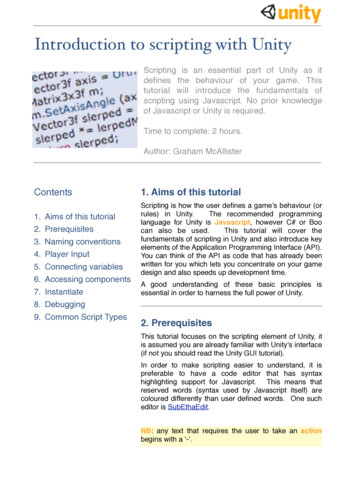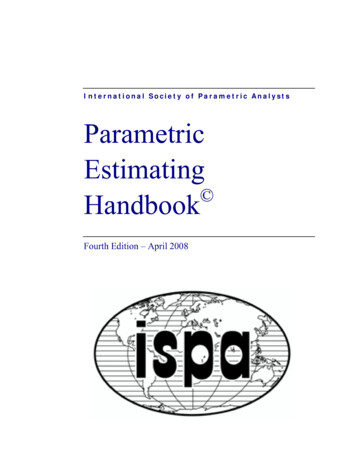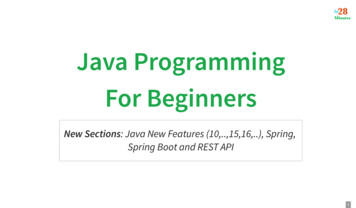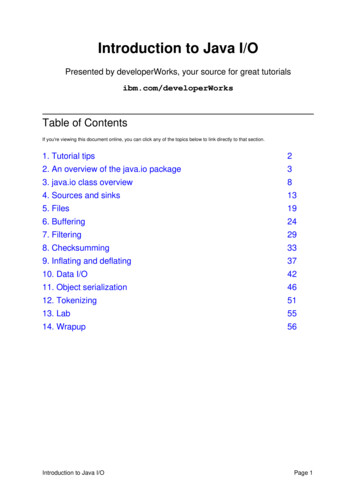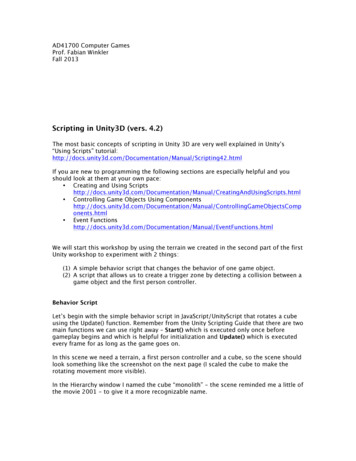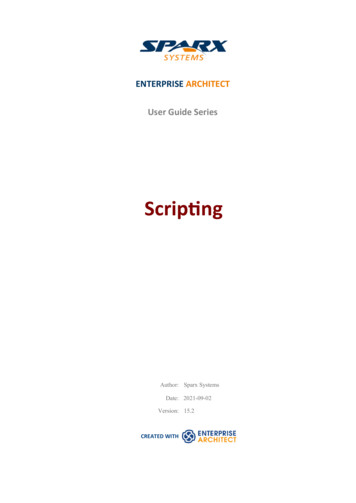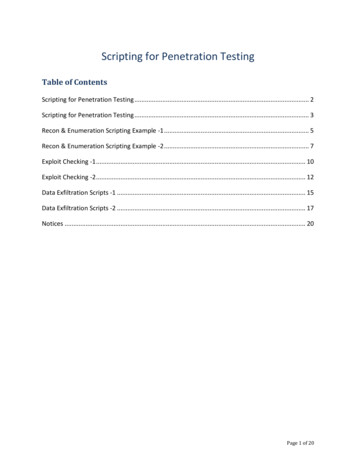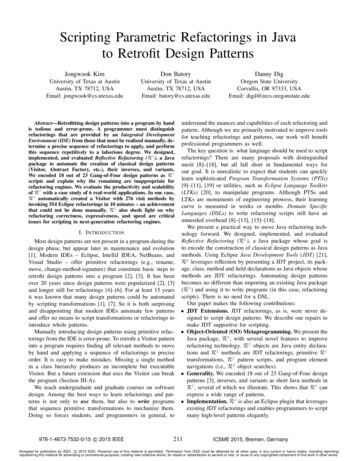
Transcription
Scripting Parametric Refactorings in Javato Retrofit Design PatternsJongwook KimDon BatoryDanny DigUniversity of Texas at AustinAustin, TX 78712, USAEmail: jongwook@cs.utexas.eduUniversity of Texas at AustinAustin, TX 78712, USAEmail: batory@cs.utexas.eduOregon State UniversityCorvallis, OR 97333, USAEmail: digd@eecs.oregonstate.eduAbstract—Retrofitting design patterns into a program by handis tedious and error-prone. A programmer must distinguishrefactorings that are provided by an Integrated DevelopmentEnvironment (IDE) from those that must be realized manually, determine a precise sequence of refactorings to apply, and performthis sequence repetitively to a laborious degree. We designed,implemented, and evaluated Reflective Refactoring (R2 ), a Javapackage to automate the creation of classical design patterns(Visitor, Abstract Factory, etc.), their inverses, and variants.We encoded 18 out of 23 Gang-of-Four design patterns as R2scripts and explain why the remaining are inappropriate forrefactoring engines. We evaluate the productivity and scalabilityof R2 with a case study of 6 real-world applications. In one case,R2 automatically created a Visitor with 276 visit methods byinvoking 554 Eclipse refactorings in 10 minutes – an achievementthat could not be done manually. R2 also sheds light on whyrefactoring correctness, expressiveness, and speed are criticalissues for scripting in next-generation refactoring engines.I. I NTRODUCTIONMost design patterns are not present in a program during thedesign phase, but appear later in maintenance and evolution[1]. Modern IDEs – Eclipse, IntelliJ IDEA, NetBeans, andVisual Studio – offer primitive refactorings (e.g., rename,move, change-method-signature) that constitute basic steps toretrofit design patterns into a program [2], [3]. It has beenover 20 years since design patterns were popularized [2], [3]and longer still for refactorings [4]–[6]. For at least 15 yearsit was known that many design patterns could be automatedby scripting transformations [1], [7]. So it is both surprisingand disappointing that modern IDEs automate few patternsand offer no means to script transformations or refactorings tointroduce whole patterns.Manually introducing design patterns using primitive refactorings from the IDE is error-prone. To retrofit a Visitor patterninto a program requires finding all relevant methods to moveby hand and applying a sequence of refactorings in preciseorder. It is easy to make mistakes. Missing a single methodin a class hierarchy produces an incomplete but executableVisitor. But a future extension that uses the Visitor can breakthe program (Section III-A).We teach undergraduate and graduate courses on softwaredesign. Among the best ways to learn refactorings and patterns is not only to use them, but also to write programsthat sequence primitive transformations to mechanize them.Doing so forces students, and programmers in general, to978-1-4673-7532-0/15 c 2015 IEEEunderstand the nuances and capabilities of each refactoring andpattern. Although we are primarily motivated to improve toolsfor teaching refactorings and patterns, our work will benefitprofessional programmers as well.The key question is: what language should be used to scriptrefactorings? There are many proposals with distinguishedmerit [8]–[18], but all fall short in fundamental ways forour goal. It is unrealistic to expect that students can quicklylearn sophisticated Program Transformation Systems (PTSs)[9]–[11], [19] or utilities, such as Eclipse Language Toolkits(LTKs) [20], to manipulate programs. Although PTSs andLTKs are monuments of engineering prowess, their learningcurve is measured in weeks or months. Domain SpecificLanguages (DSLs) to write refactoring scripts still have anunneeded overhead [8]–[13], [15]–[18].We present a practical way to move Java refactoring technology forward. We designed, implemented, and evaluatedReflective Refactoring (R2 ), a Java package whose goal isto encode the construction of classical design patterns as Javamethods. Using Eclipse Java Development Tools (JDT) [21],R2 leverages reflection by presenting a JDT project, its package, class, method and field declarations as Java objects whosemethods are JDT refactorings. Automating design patternsbecomes no different than importing an existing Java package(R2 ) and using it to write programs (in this case, refactoringscripts). There is no need for a DSL.Our paper makes the following contributions: JDT Extensions. JDT refactorings, as is, were never designed to script design patterns. We describe our repairs tomake JDT supportive for scripting. Object-Oriented (OO) Metaprogramming. We present theJava package, R2 , with several novel features to improverefactoring technology. R2 objects are Java entity declarations and R2 methods are JDT refactorings, primitive R2transformations, R2 pattern scripts, and program elementnavigations (i.e., R2 object searches). Generality. We encoded 18 out of 23 Gang-of-Four designpatterns [3], inverses, and variants as short Java methods inR2 , several of which we illustrate. This shows that R2 canexpress a wide range of patterns. Implementation. R2 is also an Eclipse plugin that leveragesexisting JDT refactorings and enables programmers to scriptmany high-level patterns elegantly.211ICSME 2015, Bremen, GermanyAccepted for publication by IEEE. c 2015 IEEE. Personal use of this material is permitted. Permission from IEEE must be obtained for all other uses, in any current or future media, including reprinting/republishing this material for advertising or promotional purposes, creating new collective works, for resale or redistribution to servers or lists, or reuse of any copyrighted component of this work in other works.
// application// application// applicationp new Picture();p.add(new Square());p.add(new Triangle());.p.draw();p new Picture();p.add(new Square());p.add(new Triangle());.p.accept(DrawVisitor.instance);p new Picturp.add( new Squp.add( new raphicGraphic1.* visit(in visit(in visit(in visit(in1.* draw() accept(in : DrawVisitor)Grap: Graphic): Picture): Square): Triangle)1.* draw()Picture add(in : Graphic) draw()SquareTriangle draw() draw()10.10.1-contains instance : DrawVisitor new DrawVisitor();PictureSquare add(in : Graphic) accept(in : DrawVisitor)(a) accept(in : DrawVisitor)TrianglePicture accept(in : DrawVisitor) add(in : Graphic) draw()(b)Fig. 1. A Visitor Pattern Refactoring. Evaluation. A case study shows the productivity and scalability of R2 . We applied a 20-line R2 script to retrofit 52pattern instances into 6 real-world applications. One caseinvoked 554 refactorings, showing that R2 scales well tolarge programs.ture maintenance task. Example: another programmer createsa SmallScreenVisitor that displays widgets for smallscreens of smartphones. When s/he passes an instance of theSmallScreenVisitor instead of the DrawVisitor, theTriangle.draw method will render the original behavior fora large screen, not the expected one for small screens.application// applicationII. A M//OTIVATINGE XAMPLEComplicating Issues. JDT refactorings were never dea new A();a new A();signedwith scripting in mind. We encountered a series ofAmong the most sophisticatedpatterns is Visitor. Thereb new B();b newareB();designand implementation issues in the latest version ofc newC();c newC();different ways to encodea Visitor; we use the one .below.EclipseJDT (Luna 4.4.1, Dec. 2014) [23] that ure 1a shows a hierarchyof graphics classes; ityto support refactoring scripts without considerableis the superclass and Picture,Square, Trianglec.accept(Visitor.singleton);are itsc.foo();effort.(Theseissues need to be addressed, regardless of oursubclasses. Each class has its own distinctdraw nics. To create a Visitor for the draw method singleton : Visitor new Visitor();(Figure 1b), a programmerfirst creates a singletonVisitor A. visit(inSeparationof Concernsa : A) foo() accept(in v : Visitor) visit(in b : B)class DrawVisitor. Next, s/he moves each draw methodFigure2a shows method draw in class Square, visit(inc : C)into the DrawVisitor class, renames it to visit, and adds after a DrawVisitor parameter was added. Figure 2ban extra parameter (namelythe classfrom whichB the method C shows the result of Eclipse moving Square.draw toBCwas moved). Referenced declarations (e.g., fields and methods) DrawVisitor.draw and leaving a delegate behind. Not foo() foo() accept(in v : Visitor) accept(in v : Visitor)must become visibleby changingtheir accessmodifiers after only was the method moved, its signature was also optimized.a method move [22]. Further,s/hecreatesadelegate(named (b)Eclipse realizes that the original draw method did not need(a)accept) for each moved method, taking its place in the its Square parameter, so Eclipse simply removes it.original class. The signature of the accept method extendsclass Square extends Graphic {the original draw signature with a DrawVisitor parametervoid draw(DrawVisitor v) {class Square extends Graphic {v.draw()void draw(DrawVisitor v) {and whose code for our example is:}.;}void accept(DrawVisitor v) {v.visit(this);}Finally, s/he replaces all calls to the draw method with calls toaccept. Note that some of these steps can be performed byJDT refactorings, but they require knowledge and familiaritywith available refactorings to know which to use and in whatorder. Further, after each step, the programmer recompiles theprogram and runs regression tests to ensure that the refactoredprogram was not corrupted.Pitfalls. It is easy to make a mistake or forget a step. Aprogrammer can inadvertently skip draw methods to move.Suppose a missed method is Triangle.draw. Although therefactored code would compile and execute correctly in thisversion, it breaks when another kind of Visitor is added in a fu-}}class DrawVisitor {static final DrawVisitor instance new DrawVisitor();(a)}class DrawVisitor {static final DrawVisitor instance new DrawVisitor();}class Graphic {int ndraws;}void draw() {.;}class Graphic {int ndraws;}error(b)Fig. 2. A JDT Refactoring Being Too Smart.As a refactoring, this optimizationis notextendsan Graphicerror.{ Butclass Trianglevoid draw(DrawVisitor v) {v.draw(this);class TriangleextendssetGraphic{whenan entireof refactoringsmustproduce a consistent}void draw(DrawVisitor v) {result,.;it is an error. Preserving }all parameters of movedndraws ;class DrawVisitor{}methodsin a Visitor pattern is essential.Twoconcerns –static final DrawVisitor}instance ptimization– wereclass DrawVisitor {void draw(Triangle t) {static final DrawVisitorbundledinto a single refactoring, insteadof being separated.;instance new DrawVisitor();ndraws ;}(a) We programmaticallyintodistinct refactorings.deactivated}error}2(b)method signature optimizations in R ; users cannot disablesuch optimizations from the Eclipse GUI.212Squ draw()
B. Need for Other (Primitive) RefactoringsSuppose that we want to “undo” an existing Visitor – eliminate the target Visitor class by moving its contents back intoexisting class hierarchies. Each visit method in the Visitoris moved back to its original class. As an example, Figure 3ashows class Triangle after such a move: Triangle hasboth accept and visit methods. When the visit methodis inlined, the accept method absorbs the visit methodbody (Figure 3b).class Triangle extends Graphic {void accept(DrawVisitor v) {this.visit(v);}inlinevoid visit(DrawVisitor v) {.;if(true) return;.;}class Triangle extends Graphic {void accept(DrawVisitor v) {.;if(true) return;.;}(b)}In Figure 4a, the super keyword invokes an overriddenmethod A.foo(). We remove super by calling a delegatemethod which calls the overridden method A.foo(). Figure 4bshows a super delegate super fooθ() which replaces thesuper.foo() call in B.bar(), thus allowing JDT to moveB.bar() to the Visitor class. Of course, super-delegatesthrow the same exception types as its super invocation.Now consider the use of super to reference fields ofa parent class. Again, JDT refuses to move methods withsuper-references to fields. Here is how we fixed this: fieldsin Java are hidden and not overridden. So we can get superreferences simply by casting to their declared type. In Figure 5,method B.foo() references field A.i with the expressionsuper.i. When B.foo() is moved to class Visitor, expression super.i is replaced with ((A)b).i.(a)}Fig. 3. Restriction of JDT inline Refactoring.Unfortunately, Eclipse refuses to inline the visit methodsince a return statement potentially interrupts executionflow. This precondition prevents automating a Visitor “undo”.We had to deactivate this precondition check to script theInverse-Visitor described in Section III-B, in effect adding anew refactoring to JDT, to accomplish our task.class A {int i;}class B extends A {int i;void foo() {super.i 0;}}class B extends A {int i;void accept(Visitor v) {v.visit(this);}}(a)C. Limited ScopeA benefit of Visitor is that a single Visitor class enables aprogrammer to quickly review all variants of a method. Often,such methods invoke the corresponding method of their parentclass. Moving methods with super calls is not only possible,it is desirable. Unfortunately, JDT refuses to move methodsthat reference super. It is not an error, but a strong limitation.We removed this limitation by replacing each super.x() callwith a call to a manufactured method super xθ(), whosebody calls super.x(); θ is just a random number to make thename of the manufactured method unique.1,2class A {void foo() {}}class A {void foo() {}}class B extends A {void foo() {}void bar() {super.foo();}}class B extends A {void foo() {}void accept(Visitor v) {v.visit(this);}void super foo () {super.foo();}}(a)class Visitor {static final Visitor instance new Visitor();void visit(B b) {b.super foo ();}}(b)Fig. 4. Rewrite that Uses super Delegate.1 Ifclass A {int i;}super.x() returns a result of type X, super xθ() also returnstype X.2 A unique name is needed for a refactoring that “undoes” or“removes” a Visitor (Section III-B). It guarantees the correct superdelegate is called, as the meaning of this and super depends onthe position in a class hierarchy from which it is invoked.class Visitor {static final Visitor instance new Visitor();void visit(B b) {((A)b).i 0;}}(b)Fig. 5. super Field Access.D. RecapMany patterns cannot be created with off-the-shelf JDTwithout considerable manual effort as existing refactorings fallshort of what is required. We have repairs for JDT, and nowour next step is scripting, which we discuss next.III. R EFLECTIVE R EFACTORINGA key decision for us was choosing the scripting language.As refactorings are transformations, our initial inclination wasto define and script refactorings in a functional or dedicatedlanguage, as others have done [8]–[14], [16]–[18]. But aswe said earlier, the learning curve to become proficient inyet another language or programming paradigm makes theseapproaches unappealing. The obvious answer is to scriptrefactorings in Java.Let P be a JDT project. We leverage the idea of reflection;R2 defines class RClass whose instances are the classdeclarations in P; instances of classes RMethod and RFieldare the method and field declarations of P, and so on. When Pis compiled, R2 creates a set of main-memory database tables(one for RClass, RMethod, RField, etc.) where each rowcorresponds to a class, a method, or a field declaration of P.These tables are not persistent; they exist only when the JDTproject for P is open.The fields of RClass, RMethod, RField, etc. – henceforth called R2 classes – also define association, inheritance,dependency relationships among table rows (foo is a methodof class A, A is a superclass of B, B belongs to package C, etc.).213
The member methods of R2 classes are JDT refactorings, simple R2 transformations, composite refactorings (our scripts),and ways to locate program elements (i.e., R2 objects).Internally, we leveraged XML scripts which Eclipse usesonly to replay refactoring histories. An R2 method call generates an XML script which we then feed to JDT to execute.In this way, we automate exactly the same procedures Eclipseusers would follow manually. R2 exposes every available JDTrefactoring as a method and a few more (Section II). Overall,we changed 51 lines in 8 JDT internal packages; the R2package consists of 5K LOC.In the following subsections, we give readers a feel for R2scripts by illustrating interesting examples.A. Automating the Visitor PatternVisitor is fully automatable as an R script. For a programmer to create a Visitor for some method m, s/he points to m asa “seed” in the Eclipse editor and invokes the makeVisitorR2 script via the Eclipse GUI. A parameter of makeVisitoris the name of the Visitor class. All methods related to m aremoved into the Visitor. So, from a programmer’s viewpoint,an R2 script is indistinguishable from an existing JDT refactoring.3Figure 6 shows our makeVisitor, a method of classRMethod. The Java keyword this refers to the “seed”method to which the script is applied. Lines 3–5 create aVisitor class (called visitorClassName) in the same packageas this and add a static Singleton field instance.Lines 7–8 find all methods (called ”relatives”) with the samesignature as this and add a new parameter of type visitorClassName to each of these methods. Calls to relativemethods have visitorClassName.instance as the defaultextra argument. Lines 10–15 move each movable method tothe Visitor class, leave behind a delegate, and rename eachmethod to visit. Lines 17–18 collect delegate relatives andrename them to accept.4 Line 20 returns the Visitor class.Looping through a list of methods and invoking a refactoring on each method would be the obvious way to add aparameter to relatives. But this is not how the JDT changemethod-signature refactoring works (Lines 7–8). It is appliedto the “seed” method only. Consider Figure 7. Suppose D.mis the method that “seeds” a change-method-signature. Allm methods in D’s class hierarchy {A.m, B.m, C.m, D.m} andinterconnected interface and class hierarchies {I1.m, I2.m,E.m} are affected by this refactoring. That is, all of thesemethods (relatives) will have their signature changed. ThemethodList variable in Line 7 is the list of all methodsin P whose signature will change. This list includes methodsthat cannot be moved, such as interface and abstractmethods. In this example, the methods moved into the Visitorare from classes {A, B, C, D, E}.23 Toadd another script, its method is added to R2 . Eclipse is then run withthe updated R2 .4 Delegate relatives include generated delegate methods and methods thatcannot be moved, e.g. interface and abstract methods.123456789101112131415161718192021// member of RMethod classRClass makeVisitor(String visitorClassName) throwsRException {RPackage pkg this.getPackage();RClass vc pkg.newClass(visitorClassName);RField singleton vc.addSingleton();RMethodList methodList this.getRelatives();RParameter newPara methodList.addParameter(vc,singleton);RMethod delegate null;for(RMethod m : methodList) {if(!m.isMovable()) continue;delegate hodList delegateList t");return vc;}Fig. 6. A makeVisitor Method.A«interface»I3 m()«interface»I1 m()«interface»I2 m()B m()C m()DEseed m() m()Fig. 7. Methods Altered by Change Signature.Note: Although Eclipse provides ways to find methods, itis still easy to miss program methods (relatives) that aredistributed over the entire program. Forgetting to move amethod when creating a Visitor manually is easy, yet it ishard to detect as no compilation errors identify non-movedmethods. R2 eliminates such errors by invoking a trustworthyR2 getRelatives() method.B. Automating the Inverse VisitorFigure 8 depicts a common scenario: An R2 programmercreates a Visitor to provide a convenient view that allowsher/him to inspect all draw methods in the graphics classhierarchy from our motivating example of Figure 1. Theprogrammer then updates the program, including Visitor methods, as part of some debugging or functionality-enhancementprocess. At which point, s/he wants to remove the Visitor toreturn the program back to its original structure.5 ݎ ݐ݅ݏ݅ݒ visitor class݁݀݅ ݐ modifiedclasses in red ି ݎ ݐ݅ݏ݅ݒ ଵFig. 8. A Common Programming Scenario.5 Of course for this to be possible, certain structures and naming conventions(as we use in our makeVisitor method) should not be altered. Effectivelythe only edits that are permitted are those that would have modified the originalprogram. Restricting modifications can be accomplished similar to GUI-basededitors, where generated code is “greyed” out and cannot be changed.214isec14‐1
BookIn this scenario, undoing a Visitor is not a roll-back, as aroll-back removes all of the programmer’s debugging edits.Instead, an Inverse-Visitor – a refactoring that removes aVisitor and preserves debugging edits – is required. Yet anotherpractical reason is if a program already contains a hand-craftedVisitor, weaving its methods back into the class hierarchywould be an optimization. Similar scenarios apply to otherdesign patterns, such as Builder and Factory Method.Figure 9 shows our inverseVisitor, a method ofRClass, that moves visit methods back to their originalclasses and deletes the Visitor class. Here is how it works:Lines 8–9 recover the original class of a visit method. Aswe turned off method signature optimization in Section II-A,the original class is encoded as the type of the visitmethod’s first parameter. Line 11 moves the method back toits original class. Lines 13–14 inline super-delegates if theyexist by replacing each call to super xθ() with super.x()(Section II-C) and then restore the original method body(which is the body of the visit method) by inlining. Lines 6–14 are performed for all visit methods. At this point, theaccept methods (i.e., the delegate methods) contain the bodyof the original methods. Lines 17–20 collect all of the acceptmethods, remove their first parameter (of type Visitor class),and restore the original name of the method. The Visitor classis then deleted in Line e : double-weight : double accept(in : PostageVisitor) accept(in : PostageVisitor) accept(in : PostageVisitor)C. MoreOpportunities getPrice(): doublevoid visit(Book book) { getWeight() : doubleif (book.getPrice() 10.0) {totalPostage book.getWeight() * 2;Design patterns have manyvariations; Visitor is no ex}PostageVisitor}ception. Consider Visitor voidPVvisit(CDofcd)Figure10 adapted from{}-totalPostage : doublevoidvisit(DVD dvd){} our example of Sec[24].ItdiffersfromtheVisitorof visit(in : Book)tion : CD)II in several ways: PVisgetTotalPostage()not a Singleton,it includesdouble{ visit(inreturn totalPostage; visit(in : DVD)statetotalPostage,ithasacustomnon-visitmethod} getTotalPostage() : doublegetTotalPostage(), and at least one of its visit methods visit(Book) references totalPostage.«interface»Item accept(in : PV)BookCD-price : double-weight : double accept(in : PV) getPrice() : double getWeight() : doublePV-totalPostage : double visit(in : Book) visit(in : CD) visit(in : DVD) getTotalPostage() : double accept(in : PV)DVD accept(in : PV)void visit(Book book) {if (book.getPrice() 10.0) {totalPostage book.getWeight() * 2;}}void visit(CD cd) {}void visit(DVD dvd) {}double getTotalPostage() {return totalPostage;}Fig. 10. Visitor with State.The Visitor variant of Figure 10 requires a slight modification of our R2 inverseVisitor method. Figure 11 showsthe modified method; it differs from Figure 9 by moving onlymethods named visitMethodName, not removing the Visitorparameter, and not deleting the Visitor class.// member of RClass classvoid inverseVisitor(String originalName) throwsRException {RMethod anyDelegate null;for(RMethod m : this.getMethodList()) {anyDelegate m.getDelegate();RParameter para m.getParameter(0);RClass returnToClass perDelegate();m.inline();}RMethodList methodList ();}Fig. 9. An inverseVisitor Method.Note: The challenge is to determine the correct order to applymove and inline refactorings. What if every visit method ismoved and then inline is applied to each visit? To see theproblem, let class A be the parent of class B and suppose bothA and B have visit methods. Now, B.visit is inlined. Bstill inherits A.visit. Eclipse recognizes that inlining mightalter program semantics and issues a warning: “method to beinlined overrides method from the parent class”. A similarwarning arises had A.visit been inlined first. The solutionis to move one method at a time, followed by an inline, asdone in Figure 9, to avoid warnings.345678910111213141516171819// member of RClass classvoid inverseVisitorWithState(String originalName,String visitMethodName) throws RException {RMethod anyDelegate null;for(RMethod m : this.getMethodList(visitMethodName)){anyDelegate m.getDelegate();RParameter para m.getParameter(0);RClass returnToClass rDelegate();m.inline();}RMethodList methodList nalName);}Fig. 11. Another inverseVisitor Variant.These examples illustrate the power of R2 : (1) we canautomate these patterns (by transforming a program withoutthese patterns into programs with these patterns), (2) we canremove these patterns (by transforming programs with handcrafted patterns into programs without those patterns), and (3)express common variations that arise in design patterns. R2offers a practical way to cover all of these possibilities.215
4.Other Patterns interface IV. OTHER PATTERNSTable1 summarizesour reviewof the Gang-of-FourDesignFigure12 is our reviewof the Gang-of-FourDesign etext [3]: 8 out of 23 patterns are fully automatable, 10fullyareautomatable,43% are partiallyautomatable,and forwethearerepartially automatable.For the remaining5 patterns,maining22%,of theirin a refactoringunsure oftheirwerolearein unsurea refactoringtoolrole(althoughsome are2tool(although Rsomeareforautomatable).We elaboratetheseautomatable).scriptsall of the 18 automatablepatternsare listedelaborate our key findings below.findingsin inthe[25].nextWesections.Design PatternAbstract FactoryAdapterBridgeBuilderChain of tory e MethodVisitorTotal12345678910111213for(RClass c : this.getClassList()) {if(c.isPublic())for(RMethod m : terface»Adapterfactory.newFactoryMethod(m);a( ) { /* TO DO */ } LegacyTarget} Parentb( ) { /* TO DO */ } a()c( ) { /* TO DO */ }Automation Possibility b()*1returnfactory; a() d() Parent(inarg) c()FullSomeUnsure} b() e()X f()Fig. c()14. A makeConcreteFactory Method.X-legacyXAdapterLegacyXFigure11. Adapter Pattern.B. Partially AutomatablePatterns1X Adapter(in l : Legacy)* d() a()10 outof 23 patternsare partially automatable,i.e., theseX e()-doc b() CommandDocument f()m2(d,p){Xpatterns produce “TO c()DOs” that must be completedbya user.1// (a)member of R I n t e r f a c e(b)classdoc ilities*2 1 RClass makeAdapter( String adapterName ,param p;X m1(in param1, in param2) between do() and aRClasslegacy adapteeclass. Given3 a client interface) { }interfaceX undo m1(in param1, in param2) 4 undo()RClasscLegacy getRPackage() . newClass( adapterName ) ;XTargetandclassinFigure15,anintermediate m2(in param)5do( ) {X undo m2(in param)class(calledAdapter)adaptsTargettoLegacy.The R26RField f c . newField ( adaptee ) ;doc.m2(param);X7c . n ewConstructor( f ) ; 16 creates the Adapterm1makeAdaptermethod in Figure}Xm2X-param1class 89that implementsinterfaceTargetand()referencesclassfor ( RMethod m : getAllMethod){undo( ) forthegenerated10c . newMethod ( m ) ;doc.undo m2(param);X do() do()11 stubs;} these are the user “TOmethodDOs”. Although} partiallyX undo() undo()12Xautomated–c . methodbodies( thisare )stillneeded – tedious and13setInterface;Xerror-pronework is done by R2 .14X15return c ;X«interface»16 }Adapter( Legacy le ) {TargetXlegacy le;810 a()} b()Figure12. A makeAdapter Method. c()5a( ) { /* TO DO */ }b( ) { /* TO DO */ }c( ) { /* TO DO */ }Fig. 12.1.AutomationPotentialof lof DesignPatterns.4.3A. Fully Automatable Patterns4.1a( ) { /* TO DO */ }Target// member of RPackageclassb( ) { /* TO DO */ }RClass makeConcreteFactory(String a()c(factoryName)) { /* TO DO */ }throwsRException{ b()RClass c()factory this.newClass(factoryName);Fully Automatable PatternsThe Visitor pattern, its inverse and variants are fully auTheVisitoraspattern,its inversevariantsare fullyautomatablethey produceno “TOandDOs”for a user.Anotheris AbstractasFactorywhich providesinterfaceconcretetomatablethey produceno “TOanDOs”for atouser.Apfactories.Figure 13bshowsinterfaceAbstractFactorypendixA sketchesotherfullyautomatablepatterns as R2thatexposesfactorymethodsforeverypublicmethods: abstract factory, command, and memento.construc35% oftor of eachclass in a given package: the packpatternsare inpublicthis category.age of Figure 13a contains classes A and B; the interfaceAbstractFactoryis implemented4.2Partially AutomatablePatterns by concrete factoryclass ConcreteFactory in Figure 13b. Figure 14 is the43%of
We present a practical way to move Java refactoring tech-nology forward. We designed, implemented, and evaluated Reflective Refactoring (R2), a Java package whose goal is to encode the construction of classical design patterns as Java methods. Using Eclipse Java Development Tools (JDT) [21


